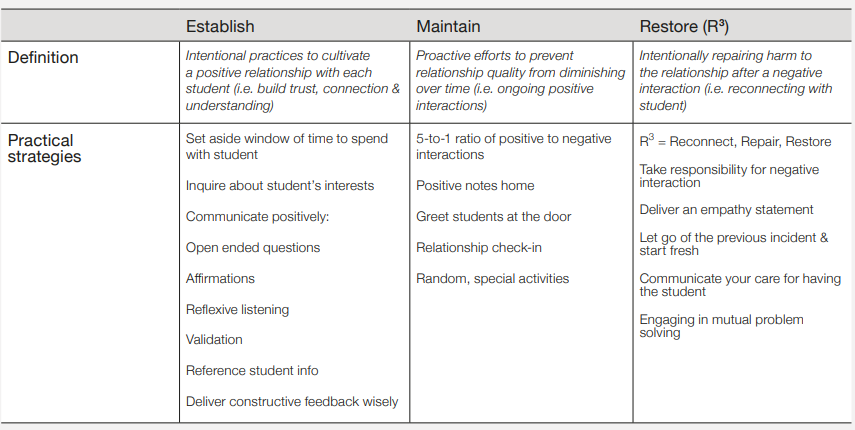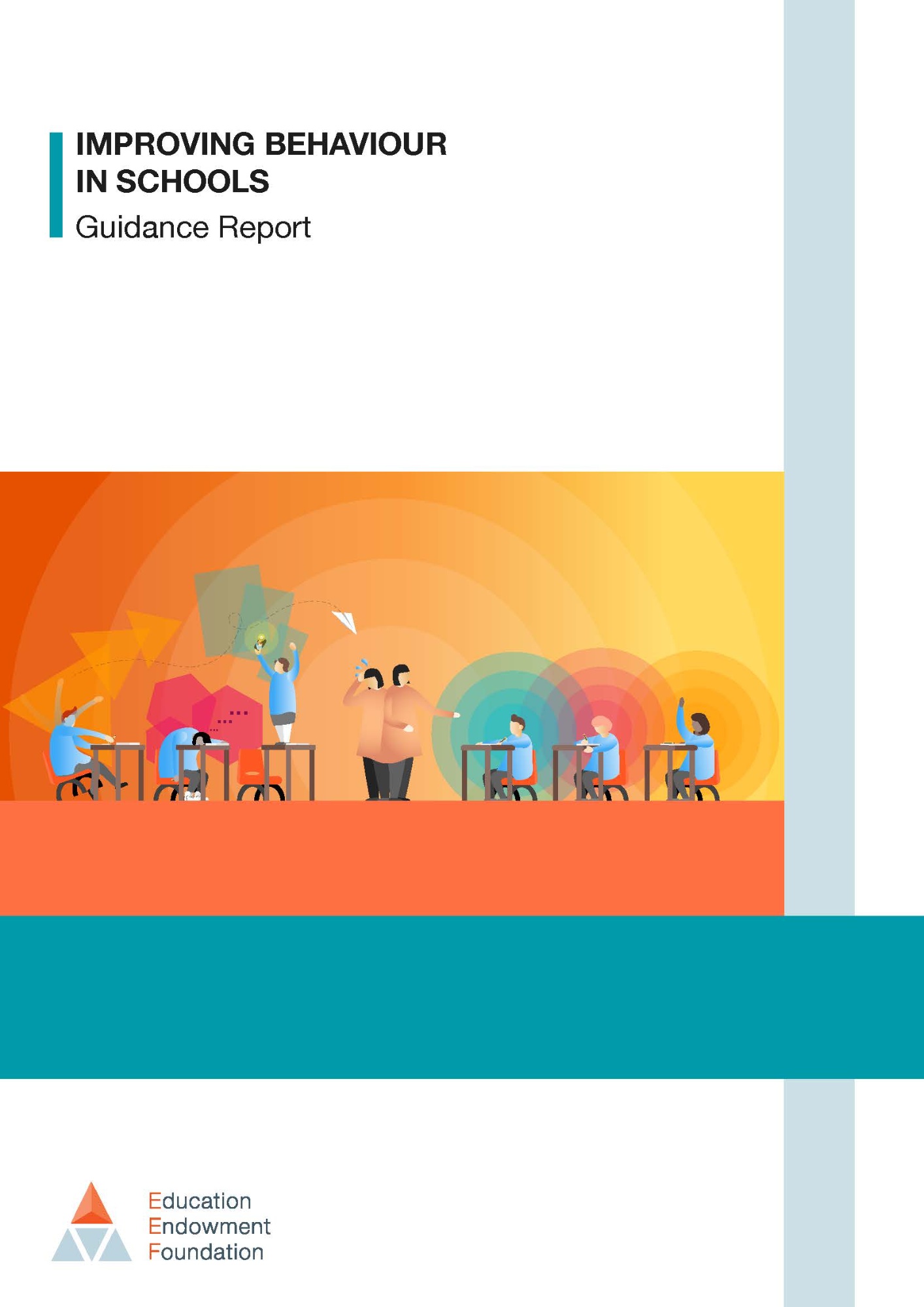Building Positive Behaviour with the EEF's 'Establish, Maintain, Restore' Framework

The Education Endowment Foundation (EEF) published a comprehensive research review in 2021 called Improving Behaviour In Schools. This guidance report has three sections.
The first details proactive strategies that can be deployed at classroom level to reduce the chance of misbehaviour occurring: a school-wide focus on these strategies should reduce efforts expended reacting to poor behaviour.
Next, the guidance covers reactive strategies for supporting pupils to improve their behaviour when they have misbehaved or have a chronic issue with their behaviour in school.
Finally, the guidance covers implementation. Implementing approaches to behaviour strategically and consistently is likely to be more important than the choice of approach itself, and the impact of any good strategy can be enhanced by getting this right.
Establish, Maintain, Restore
The 'Establish, Maintain, Restore' method is of particular interest:

This framework emphasises proactive strategies to create a positive classroom environment, focusing on prevention and early intervention over reactive measures.
My Key Takeaways from the EEF Review:
- Establish: This phase focuses on creating a clear and consistent classroom culture. This includes:
- Clear expectations: Explicitly and consistently communicate rules and routines.
- Positive relationships: Build strong relationships with students based on trust and respect.
- High-quality teaching: Engaging lessons and differentiated instruction minimise disruptive behaviours.
- Maintain: This phase focuses on sustaining a positive classroom environment. This involves:
- Proactive strategies: Use clear and consistent routines, visual cues, and positive reinforcement.
- Early intervention: Address minor disruptions promptly and effectively.
- Restore: This phase focuses on addressing more challenging behaviours. It emphasises:
- Restorative approaches: Focus on repairing harm and rebuilding relationships.
- Calm and supportive responses: Avoid escalation and prioritise de-escalation techniques.
- Collaborative problem-solving: Involve students in finding solutions to behavioural challenges.
For the experienced teacher perhaps none of this is new, but more recently we seem to be presented with two camps when it comes to behaviour management support and training.
We have the Tom Bennett camp - his ‘Running the Room’ theories of behaviour management with an emphasis on teacher strategies for behaviour management and the importance of rules and consequences (Running the Room: The Teacher's Guide to Behaviour 2020) and the Paul Dix camp (When the Adults Change 2017) which puts the emphasis on teacher behaviours rather than pupils and states the importance of establishing secure relationships with a deeper insight into the cause of, and the response to, learner behaviours.
Tom Bennett has gained a significant following for his emphasis on clear boundaries, consistent consequences, and the importance of teacher authority in creating a conducive learning environment.
However, some critics argue that Bennett's approach can be overly punitive and may not adequately address the root causes of student behaviour. They suggest that focusing solely on discipline without considering the emotional and social well-being of students can lead to negative outcomes, such as increased anxiety, lower self-esteem, and a sense of alienation.
Furthermore, some argue that Bennett's views on teacher authority can be interpreted as a power dynamic that may not be conducive to creating a positive and collaborative learning environment. They suggest that a more student-centred approach, which emphasises respect, empathy, and understanding, can be more effective in fostering positive behaviour and promoting student engagement.
Some educators find Bennett’s approach to be helpful and effective, while others prefer alternative strategies that prioritise student well-being and collaboration. It is for us as expert practitioners to balance the perspectives to ensure a successful learning environment in which everyone (including the teacher) thrives. The EEF report, I believe, does this very successfully.
Connecting to Trauma-Informed Practice
The EEF's framework aligns strongly with trauma-informed practice. Trauma can significantly impact a child's behaviour, leading to:
- Difficulty regulating emotions: Outbursts, meltdowns, and anxiety.
- Challenges with social interaction: Difficulty building and maintaining relationships.
- Hypervigilance: Constant scanning for threats, leading to anxiety and easily triggered responses.
Punitive approaches, such as detentions or exclusions, can exacerbate these challenges. They can:
- Increase trauma symptoms: Heighten anxiety, fear, and feelings of shame and isolation.
- Damage relationships: Erode trust between the student and the teacher.
- Reinforce negative behaviour cycles: Lead to further escalation and disengagement.
Trauma-Informed Alternatives
Instead of punitive measures, the EEF's framework, combined with trauma-informed principles, improves outcomes by:
- Emphasising safety and predictability: Creating a consistent and supportive classroom environment.
- Building strong relationships: Prioritising empathy, compassion, and understanding.
- Using restorative practices: Focusing on repairing harm and rebuilding relationships through dialogue and problem-solving.
- Providing emotional regulation support: Teaching students self-regulation skills, such as deep breathing and mindfulness.
- Offering individualised support: Addressing individual needs and providing appropriate interventions.
Conclusion
 The EEF's research review provides valuable guidance for creating positive and effective classroom environments. By prioritising prevention, early intervention, and restorative approaches, educators can create a more supportive and inclusive learning environment for all students, not just those who have experienced trauma.
The EEF's research review provides valuable guidance for creating positive and effective classroom environments. By prioritising prevention, early intervention, and restorative approaches, educators can create a more supportive and inclusive learning environment for all students, not just those who have experienced trauma.
The link to this research report can be found here:
https://educationendowmentfoundation.org.uk/education-evidence/guidance-reports/behaviour
By Susan Marbe, Director of ITT, West Essex SCITT
Read other Evidence Led Practice blog posts here.
